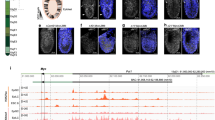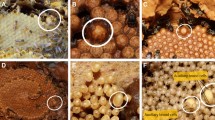Summary
In Drosophila melanogaster, the P-M system of hybrid dysgenesis is a syndrome of germ line abnormalities, including temperature dependent gonadal dysgenesis (GD sterility), high rates of mutation and male recombination, which occurs in some interstrain hybrids but only from one of the two crosses. In the P-M system, hybrid dysgenesis results from interaction between chromosomally transposable elements of the P element family and a particular extrachromosomal state referred to as the M cytotype. Cytotype (M or P) is known to be determined by the absence or presence of chromosomal factors, but principally with limited cytoplasmic transmission.
In a series of experiments in which F1 hybrid females from various P and M strains were submitted to different preadult and ageing temperature treatments, it was found that the cytotype switch is strongly temperature-dependent in the F1 females from M ♀ x P ♂ but not in the reciprocal cross. In the F1 females from the former cross, a strong M cytotype occurs at a low developmental temperature (18° C) and a weak M cytotype occurs at a high developmental temperature (26.5° C). On the other hand, a high ageing temperature applied after a low developmental temperature switches the cytotype from M to P and reciprocally, a low ageing temperature applied after a high developmental temperature switches the cytotype from P to M.
This thermo-reversibility of the extrachromosomal state exists only in the F1 females from M mothers but not in the F1 females from P mothers; this dissymmetrical behavior is discussed in relation to the mechanism proposed by O'Hare and Rubin (1983) which explains cytotype determination by a positive feedback of the regulator of the P transposase on its own level of activity.
Similar content being viewed by others
References
Anxolabéhère D, Nouaud D, Périquet G (1982) Etude de la variabilité du système P.M. de dysgénésie des hybrides entre populations de Drosophila melanogaster. CR Acad Sc Paris 294:913–918
Bingham PM, Kidwell MG, Rubin GM (1982) The molecular basis of P.M. hybrid dysgenesis: the role of the P element, a P strain specific transposon family. Cell 29:995–1004
Bregliano JC, Kidwell MG (1983) Hybrid dysgenesis determinants. In: Shapiro J (ed) Mobile genetic elements. Academic Press, New York, 363–410
Bregliano JC, Picard G, Bucheton A, Lavige JM, Pelisson A, L'Héritier PH (1980) Hybrid dysgenesis in Drosophila melanogaster. Science 207:606–611
Engels WR (1979a) Hybrid dysgenesis in Drosophila melanogaster: rules of inheritance of female sterility. Genet Res Camb 33:219–236
Engels WR (1979b) Extrachromosomal control of mutability in Drosophila melanogaster. Proc Natl Acad Sci USA 76:4011–4015
Engels WR (1981) Hybrid dysgenesis in Drosophila and the stochastic loss hypothesis. Cold Spring Harbor Symp Quant Biol 45:561–565
Kidwell MG (1979) Hybrid dysgenesis in Drosophila melanogaster: the relationship between P.M. and I.R. interaction systems. Genet Res Camb 33:205–218
Kidwell MG (1982) Interspecific hybrid sterility. In: Ashburner M, Carson HL, Thompson JN Jr (eds) The genetics and biology of Drosophila, vol 3c. Academic Press, New York, p 125–154
Kidwell MG (1983) Hybrid dygenesis in Drosophila melanogaster: factors affecting chromosomal contamination in the P.M. system. Genetics 104:317–341
Kidwell MG, Novy JB, (1979) Hybrid dysgenesis in Drosophila melanogaster: sterility resulting from gonadal dysgenesis in the P.M. system. Genetics 92:1127–1140
Kidwell MG, Kidwell JF, Sved JA (1977) Hybrid dygenesis in Drosophila melanogaster: a syndrome of aberrant traits including mutation, sterility and male recombination. Genetics 86:813–833
O'Hare K, Rubin GM (1983) Structure of P transposable elements and their sites of insertion and excision in the Drosophila melanogaster genome. Cell 34:25–35
Périquet G (1980) “Atrophie gonadique” character and hybrid dysgenesis in Drosophila melanogaster. Biol Cell 39:7–12
Périquet G, Anxolabéhère D (1982) Elements causing hybrid dysgenesis on the second chromosome of Drosophila melanogaster. Mol Gen Genet 186:309–314
Rubin GM, Kidwell MG, Bingham PM (1982) The molecular basis of P.M. hybrid dysgenesis: the nature of induced mutations. Cell 29:987–994
Schaefer RE, Kidwell MG, Fausto-Sterling A (1979) Hybrid dysgenesis in Drosophila melanogaster: morphological and cytological studies of ovarian dysgenesis. Genetics 92:1141–1152
Sved JA (1979) The “hybrid dysgenesis” syndrome in Drosophila melanogaster. Bio Science 29:659–664
Author information
Authors and Affiliations
Additional information
Communicated by W. Gehring
Rights and permissions
About this article
Cite this article
Ronsseray, S., Anxolabéhère, D. & Périquet, G. Hybrid dysgenesis in Drosophila melanogaster: Influence of temperature on cytotype determination in the P-M system. Mol Gen Genet 196, 17–23 (1984). https://doi.org/10.1007/BF00334086
Received:
Issue Date:
DOI: https://doi.org/10.1007/BF00334086




